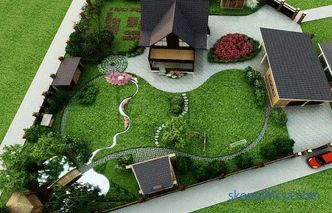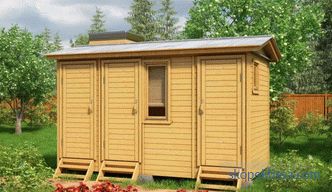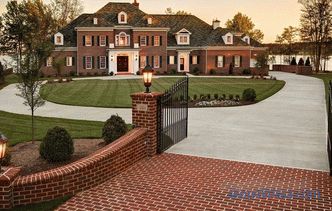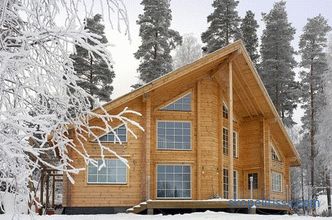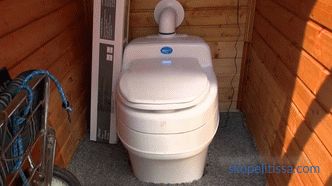The task of how to sheathe the walls in a wooden house inside occurs often. Perhaps, only glued laminated timber and a rounded log meet high decorative requirements, and the walls of them do not need interior decoration. In other cases, additional processing is necessary, especially since a wooden house may have flaws in the curvature of the walls, and the inner lining using a batten or frame allows them to be compensated.
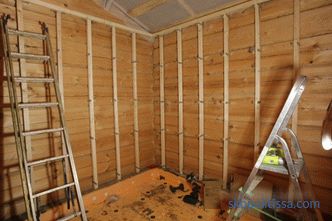
Sometimes it may be necessary to trim the wooden walls for wooden walls
Features of a wooden house
With all its wonderful qualities, a wooden house has flaws that are caused solely by the properties of the wood itself.
Wood is the only basic building material that is classified as combustible. Therefore, the rules for the installation of internal electrical networks are very strict. Cables or wires can be mounted either by an open method, using non-flammable gaskets or mounting on insulators, or inside metal pipes, which reliably localize wiring from wooden walls. Therefore, the second method is the only one that allows the hidden laying of electrical circuits inside the framework cavities or in the free space that forms the crate between the main wall and the casing.
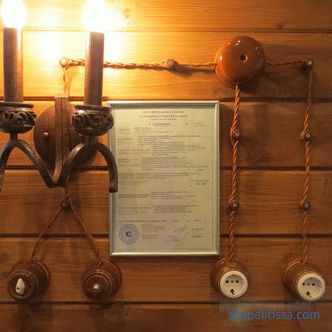
Open wiring looks good only in the interior in the style of "retro"
Walls in a wooden house, unlike brick or building blocks are characterized by significant shrinkage, which is caused by changes in the size of the material itself during the drying process. Of course, it is insignificant for glued laminated timber, but in other cases it is recommended to start interior decoration a year later.
But even after a year, the shrinkage does not end - the walls of the house, though not more slowly, but continue to "decrease" in height.
This factor, plus the susceptibility of wooden structures to changes in air humidity, does not allow “directly” reveting the walls with stone or ceramic tiles. Therefore, before you finish the walls in a wooden house inside you need to prepare a flat base that would be stable in any humidity conditions.
The same need arises if the interior of a wooden house wants to use decorative plaster or wallpaper. Therefore, for such a finish, the inner wall cladding is used with sheet materials resistant to changes in humidity.
Wood paneling
In most cases, the interior walls of a wooden house are trimmed with panels that preserve the aesthetics and breathing properties of the tree. These include lining, imitation lumber, block house and the usual edged board.
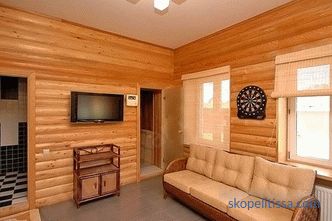
Wall cladding with block-house
On our website you can find contacts of construction companies that offer insulation and house finishing services. Directly to communicate with representatives, you can visit the exhibition of houses "Low-rise Country".
Wall paneling
This is the most popular type of wood paneling for interior decoration. And interestingly, the name "lining" is used only by domestic manufacturers and sellers. Moreover, it was also distributed to the sheathing boards of foreign production, which, although they differ in the type of profile, but have a similar spike-to-groove connection. Therefore, you can find several varieties of lining on the market:
-
standard - a domestic panel according to GOST 8242-88 with the same long spike and groove depth (after connecting the spike is not visible) and chamfered on the long side front part with an angle of 30 °;
-
calm - the profile is almost identical to the "standard" with the exception of the rounded chamfer;
-
eurolining in the standard version ( DIN 68-126) has a beveled chamfer of the front part next to an elongated spike (its size is greater than the depth of the groove) - after the connection a characteristic wide seam is formed;
-
soft line - the same profile as the eurolining, but with a rounded chamfer;
-
Finn — visually very similar to “calm”, but the rounding has a larger radius, resulting in the front part of the profile resembles a part of an oval, but not a flat surface;
-
Landhouse is another representative of lining of foreign origin with the same spike and groove sizes as in eurolining, but with a decorative relief of the front surface.
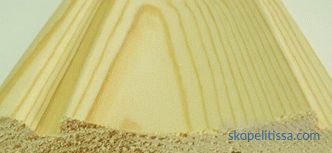
The Landhaus carriage has an unusual relief.
There are other decorative forms of wooden slatted panels. They differ from the usual "non-linear" front surface. Sometimes these finishing materials are called wooden wallpaper, but according to the method of interconnecting and fastening to the crate - this is a typical lining.
The most famous among them are:
-
“wave” and “breeze”, which differ from each other in height and width of the relief profile;
-
"brick" with transversely cut grooves imitating vertical masonry joints;
-
"house" - a symmetrical volume surface resembling a sloping roof.
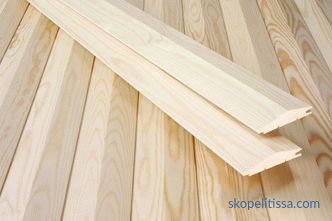
The lining of the house is no less original than the landhouse
Block house and bar imitation
Another option than to sheathe the walls in a wooden house. In principle, many manufacturers and these panels are referred to as clapboard with the same principles of mounting on the batten, but in a more "thick format." Both coatings are more often used outside, especially when insulated using a curtain facade technology, but thin samples are also used for interior decoration of walls in a wooden house, so as not to disrupt the aesthetics of a log house or a rounded log.
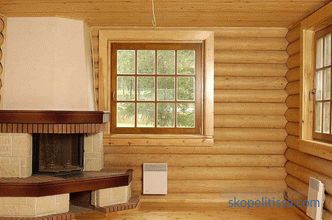
A block house in the interior creates a complete illusion of a house from a log
It can be interesting! In The article on the following link read about the trim house block house.
The dimensions of the block house and the imitation of the timber are not defined by any standard, therefore each manufacturer has its own standard model line.
Usually, a block-house with a thickness of 18 to 22 mm is chosen for interior decoration, but sometimes panels with a maximum profile height of 25 mm are also used, which is considered universal. The same range of thickness for imitation timber - 18-22 mm, although there are thinner samples, which coincide in this parameter with clapboard.
Imitation of a bar and a block house are mounted horizontally, therefore they usually have a length longer than that of the wall paneling - up to 6 m. And for greater similarity with their “full-sized” analogues, the width of the profile is also increased.
Preference when choosing thicker than lining, lath panels justify the following advantages:
-
high resistance to mechanical stress;
-
the best level of thermal insulation (in the form of interior decoration of external walls);
-
higher sound insulation (when covering external walls and interior partitions).
Clearly about the block house on the video:
Features of the choice of wood type
Pine wood trim is most available. This is the most common coniferous wood, easy to process and with a fairly high performance properties. Among the drawbacks can be mentioned low hardness and low resistance to high humidity, but for residential residential heated premises this is not essential.
Larch wood panels are much more expensive than pine. Although this breed also applies to domestic and common, but high prices on the world market have an impact on the domestic. The advantages are higher Brinell hardness and resistance to fungal and mold damage, even in high humidity conditions. And this is a better choice than to decorate the walls in a wooden house inside, if it is intended for seasonal living.
The Brinell Method is one of the most commonly used methods for determining the hardness of a material. Two substances are compressed among themselves, and then the depth of the print is measured.
Cedar or oak panels can be of both domestic and foreign production. For example, block house and lining of Canadian cedar are elite finishing materials. Soft in processing, but durable wood of both species, is polished to a shine. It has beautiful shades of color and is resistant to high humidity. As well as finishing materials of other valuable types of wood, the panels are produced in the format only for interior plating.
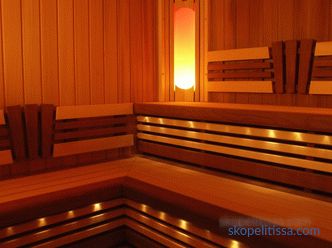
Red Canadian cedar is not in vain considered to be an elite material , to decorate the walls of a wooden house using a regular edged board. And the frame technology of construction of internal partitions is a classic way of dividing the internal space into rooms.
There is also a planed and a quarter board (or a quarter board), which is used for "deaf" covering of planes without gaps between adjacent elements. It is considered to be the predecessor of modern wall paneling, and therefore, in their prices, manufacturers sometimes point it out in the same section as the rest of the wall panels for wall cladding. But unlike "thin" wall paneling, it is closer by standards to an edged board, and the most common thickness dimensions for interior plating are 20 and 25 mm.
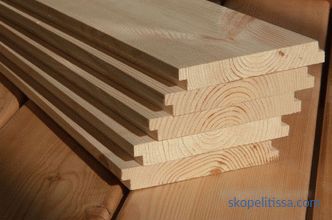
The board and a quarter are still relevant today
Other options
In addition to the natural wood, there are alternative ways to sheathe wooden walls inside the house.
The most accessible are batten panels made of fiberboard, laminated to any grade and shade of natural wood.The lack of such panels as a finishing material - low resistance to mechanical damage and high humidity.
After the implementation of laminated wood technology in the production of finishing materials, spliced lining, imitation of timber and block house appeared on the market. Unlike natural analogues, they have no wood defects, as well as the notion “grade B”. If a knot occurs, it is exclusively "live".

If you take a closer look, you can see the joints of adjacent lamellae
on the spliced clapboard. Despite the visually perfect condition, the spliced materials have limitations. The presence of seams and the heterogeneity of the structure can eventually lead to delamination of the panel.
Several beautiful options for finishing a wooden house in the video:
It might be interesting! In the article on the following link read about the interior decoration of the country house.
Conclusion
There are enough options to beat the walls in a wooden house. A variety of coatings can be used for decoration, the range of which is not much less than when working with walls made of other materials. True, it is necessary to take into account that to finish a wooden house with tiles or wallpaper, you will have to use the standard technology of leveling the walls on the crate or additionally make a frame partition with plasterboard, moisture resistant plywood or OSB. The expediency of such a decision is very doubtful, because in this case, apart from the loss of some useful volume of the room, all the beauty of the wooden walls will be hidden behind the veneer. Therefore, what exactly to choose, it is necessary in each individual case to decide individually and it is strongly recommended to consult with experts who will be able to evaluate all the nuances on the spot.
